The Human Stack Ethos
Hi! We Are The Human Stack
We want to see humans better represented within information systems. If what you read below resonates with you, then you’ve found your digital tribe, and we'd love it if you let us know. We break up our Ethos into 4 words, all starting with M: Model, Mindset, Methods, and Movement. Read on to learn more!
The Model
Meet Amanda
Amanda leads a nonprofit in St Louis and has worked in human services for several decades. But technology is the Achilles heel of her organization. The system her organization uses has questionable data, isn’t well used, and every week it feels like Amanda hears of another issue. Despite a six-figure investment, the system with so much promise is mostly a donation and address ledger. Amanda feels like it should do more, but when she talks about it with professionals, the language turns incomprehensible. The recommendations seem to boil down to a new system or expensive services that sound like people just doing their jobs in the system, which was already supposed to be happening.
What Amanda and many others like her feel is the result of an industry so focused on building and selling technology that there isn’t room for humans. When technology conversations happen, Amanda struggles to keep up and often feels like she doesn’t belong. And Amanda is right because Technology today is focused solely on the The Tech Stack.
The Tech Stack is the code base, applications, and platforms that comprise multiple systems an organization uses. The focus of technology is technology, and that’s not surprising, but humans like Amanda and her team are being left out. Humans are underrepresented in technology because there isn’t a place to measure the human side of technology.
We need a stack to measure those elements that are uniquely human. We call this second stack, The Human Stack. It creates a more balanced system that can account for the needs that Amanda and her team have with technology.
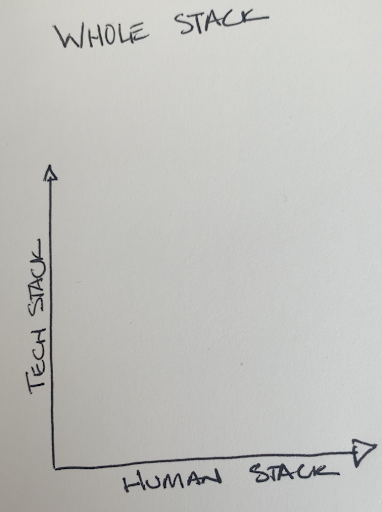
The core of our model is simple. Technology today is a one-dimensional model measured on a single axis called The Tech Stack. But this single stack was built to architect digital code. Humans need a second stack for their advancement (hence The Human Stack). Check out the simple journal view of the model; simple right?
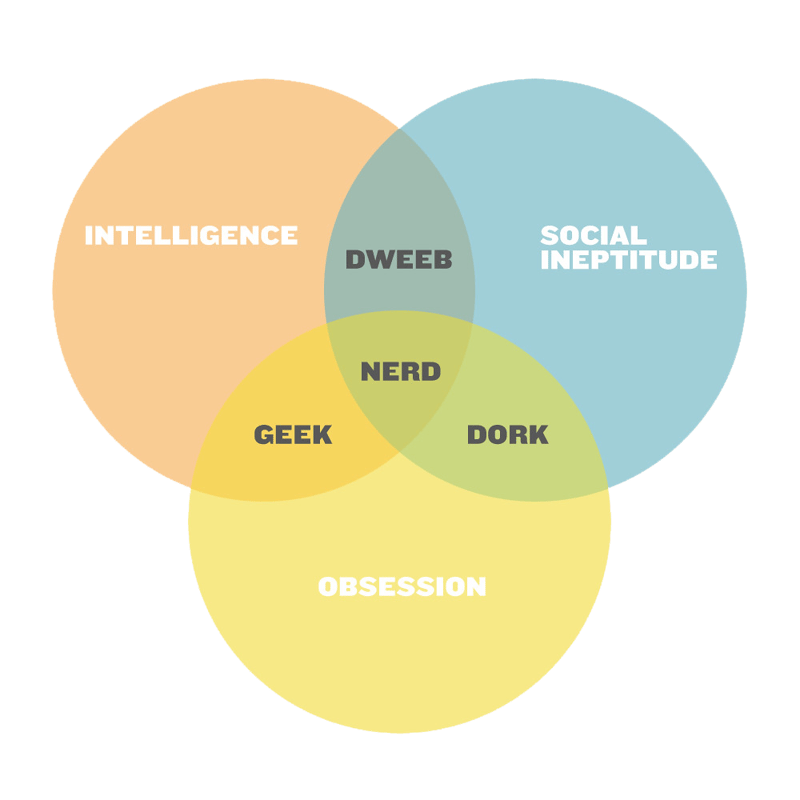
Look, we’re big technology fans. We’re geeks/nerds (but not dorks or dweebs). We love technology and still recognize that there are diminishing returns in its ability to create scalable social change. For that, we need humans. We see humans getting lost in the shuffle, especially in the nonprofit ecosystem for small nonprofits (with expenses under $1M accounting for 77% of all organizations).*
What If Tech Was The Auto Industry?
For over a decade, we ran a consulting firm called Now IT Matters that implemented technology for hundreds of nonprofits, but we became concerned with the patterns that emerged in the market.
Imagine that the technology space is like the car industry. Big enterprise cloud platforms like Google, Microsoft, and Salesforce act as the car manufacturers in our make-believe story. Consulting partners, like Now IT Matters, are car dealerships where organizations would come and order their CRM. We’d work with them to pick the proper trim, load up the options like online donations, sustainer campaigns to attract recurring donors, and a customer 360-view of whatever marketing the manufacturer sent down.
And after the CRM Launch, when the car was delivered, we found that nonprofit teams could not drive effectively.
Nonprofits don't need dealerships. Nonprofits need driving schools.
That's where The Human Stack comes in. We raise awareness through our Mindset. And we develop systemic change and predictable outcomes through our Methods. So that we can create long-term change through a Movement.
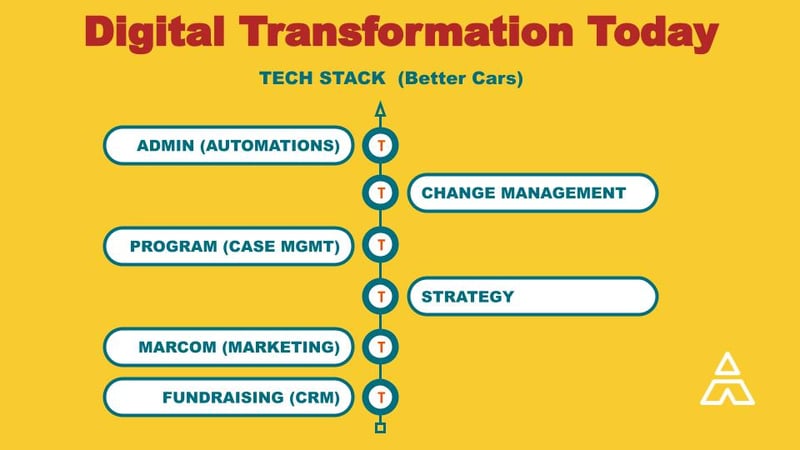
Digital Transformation today looks like a series of technology phases that organizations undergo to improve the Tech Stack and make "better cars." Often this starts with a better fundraising system and involves a CRM. Then maybe the marketing and communications team is looking to up their system, so there's another phase of work to integrate marketing with the CRM and other constituent data.
And by this time, it's becoming clear that some sort of strategy would be helpful, so a strategy review is performed to look at the strategic plan and map out future work before a case management system for the program team is installed.
But staff are becoming frustrated with the amount of system change, so a change management project is performed to ensure an ordered approach to changes to the tech stack.
And by then, the system feels unwieldy for the system admins who feel that some automation could reduce workload. And there is some concern that the system admins may leave to join a consulting firm, so to keep them happy (and in case they go), an automation project is completed.
This is what digital transformation looks like today. All projects and phases are performed to develop the Tech Stack. All to make better cars. Even change management and strategy are focused on the tech stack.
Digital Transformation today tries to solve human issues with tech solutions, like trying to solve a driver issue with a better car.
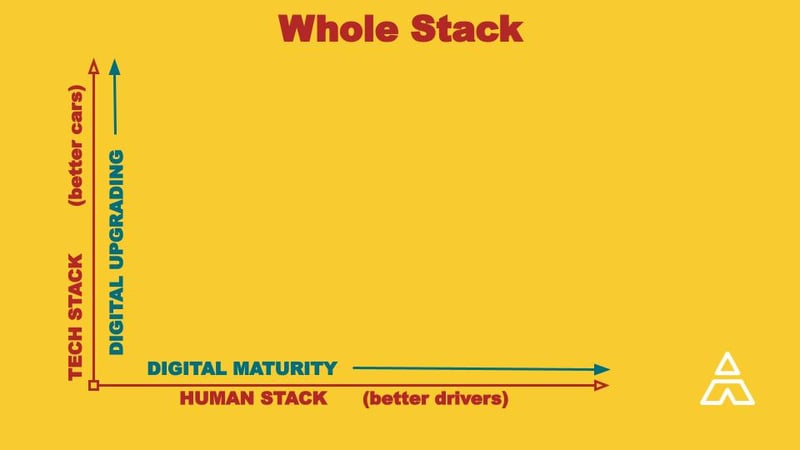
True Digital Transformation requires a second dimension for human progress called Digital Maturity. Adding a line for human progress gives space to measure progress, identify needs, and develop standards for human behavior.
Each line has its purpose. The purpose of the Tech Stack is digital upgrading (better cars). Better technology allows humans to increase the quality of decisions that can come from data. The purpose of the human stack is Digital Maturity (better drivers).
The power of this model is that tech and human problems can be solved separately from each other.
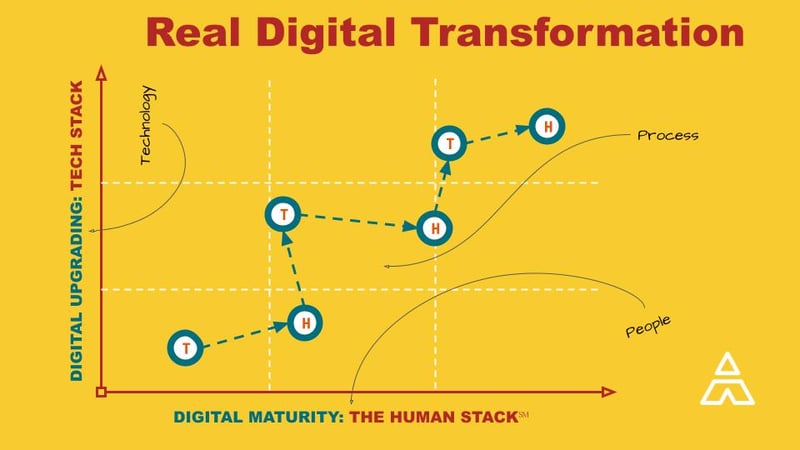
Digital Transformation is when we have great cars and great drivers. This model creates a surface area for solutions that are created.
And before we leave the car world, it’s important not to think of Formula 1 as the ultimate digital maturity model. That’s not realistic. Instead, the car fits the needs of the organization. The perfect car (tech stack) for a smaller nonprofit may be a minivan. And it’s not just a single car. Organizations need multiple cars, which we’ll talk about in Methods.
The Mindset
To change the way technology thinks, we create code. To change the way humans think, we change our minds through ideas. To The Human Stack, ideas are assets with immense power. For example, our model above is a mindset. It’s the core of our brand, so it sticks out, but it’s not the only one.
You’ve heard of think tanks, right? It’s where fancy ideas are created. And you’ve heard of banks, where valuables are stored. Well, The Human Stack is a think bank where we create and store ideas that have value. We are hungry for new ones, and we hope you’ll co-create them with us because exchanging mindsets is what powers movements, as you’ll read later on.
We’re creating new ideas of value all the time, but here are a few that have created real traction.
You Need A North Star
EveryAction put out a report with an astonishing claim (that sorta ruined Now IT Matters). In 2018 it found that 90% of organizations collect data, but less than 40% use that data to make decisions.* Every technology professional who hears this smiles and nods their head because it matches our experience. To put this into our model: 90% of organizations have cars, but less than 40% drive them.
Our North Star = Data-Informed Decisions
One of the primary causes of this failure to make decisions with data is that most executives in charge of technology don’t have a north star for technology. Without a better north star, the decision becomes which software. A better north star would be: the goal of technology is data-informed decisions.
Theory of Change
Our Theory of Change is a simple model that starts with data and ends with insight. Data is the smallest unit of meaning. Think of data as cells on a spreadsheet; they don't have any labels and are just listed in cells. Information, on the other hand, is data with context and does have labels that have meaning. Systems take data and give information, and by default, information systems are takers, not givers. Information is only as good as the data that created it. One of the main reasons that organizations don't use the data they collect to make decisions is that they know better than to trust that data. They've seen how it was collected, and they know it's not accurate. Executives may not even expect their information systems to deliver decision-quality information because they are so used to making decisions based on their experience and instinct. Trusted accurate data, on the other hand, turns into information that is combined with other information sources to create insight. Information Systems should be developed until they outperform executive instinct.
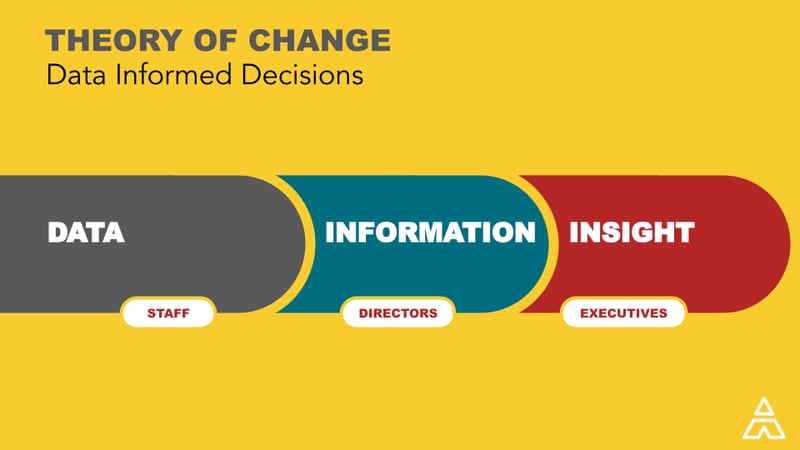
Base Codes & Binaries
The base code of the tech stack is a binary of zeros and ones. It's incredible to consider that every pixel we see on a screen from stock price, news article, TikTok video, or text message celebrating an announcement is a massive nested if statement that boils down to 0 or 1. The forcing constraint is accuracy. The tech stack 100% runs on the accurate calculation of True or False. There's no room for middle ground on the tech stack because middle ground is an infinite loop.
The human stack, on the other hand, has a binary based on In/Out, and its forcing constraint is belonging. We, humans, are herd animals. The most important element of our identity is highly related to our sense of inclusion and belonging to the groups that matter to us. Many tech issues that seem like computer problems are humans compensating for feeling like they don't belong in the group based on their work performance. For people who don’t consider themselves good at tech, the increasing work performance that depends on technology systems creates negative emotions like insecurity and fear. Since this is predictable and expected, it would be reasonable to think that technology consultants and professional services provide relief from these fears, but unfortunately, that’s not the reality. Instead of focusing on the needs of humans who don’t do tech, most of our focus is spent on those who show more aptitude, which can further strain the sense of belonging for the staff who struggle with tech the most.
The net effects of negative emotions are the leading cause of persistent adoption failure. Users forget the login link and are too embarrassed to ask for it, so they avoid the system; shame sets in, and users opt-out and turn to the technology that doesn’t judge them, spreadsheets. Shame causes more tech problems than UX and adoption is a human stack metric.
When we understand that the core problems with digital maturity are feelings of inclusion or exclusion, the solutions we create focus on the recognition and dignity of humans before prioritizing technical execution. The worst-case scenario for the human stack is digital cultures that center around in/out dynamics. A feelings first approach focuses on the humans LEAST likely to adopt the system. If Philanthropic funders, technology providers, enterprise platforms, and consulting partners approached technology issues on the human stack through the lens of belonging, our services, technology, and funding would better align with the emotional issues of users that are bad at tech. Moving humans from the bad at tech identity toward something more positive is digital maturity. And it’s as much about self-perception as it is skill building. The long-term impacts are enormous when we create that lift for an entire department.
Change Saturation: Disruption vs. Capacity
There is only so much change that humans and organizations have the capacity to deal with effectively. If saturation levels are exceeded by disruption exceeding capacity for change, humans act in predictable ways, one of which is they experience negative emotions.
Let's say a coffee cup is an organization's capacity for change, and coffee is a disruption. When an organization searches for a technology solution, it's because its cup is likely almost full of coffee. If we view the world through this lens, we should immediately either increase the cup size or decrease the amount of coffee. Instead, we often begin our work with a highly saturated organization by pouring a new CRM into a mostly full cup. This is problematic because CRM implementations are one of the most disruptive activities that an organization can experience. The intent is to create a larger cup but to create a larger cup, more disruption must be introduced, and the outcome is that coffee gets spilled over the side of the cup because there's more coffee than the cup can hold.
The solution is to help an organization drive technology in their car instead of buying a new one. Even if they need a new car/CRM, it will take months of setup, configuration, and data migration before they would be ready to drive that new car. If they need a new car or just could use the one they already own, the immediate next step is to teach their team how to drive any CRM. That is why we developed Digital Guidance®.
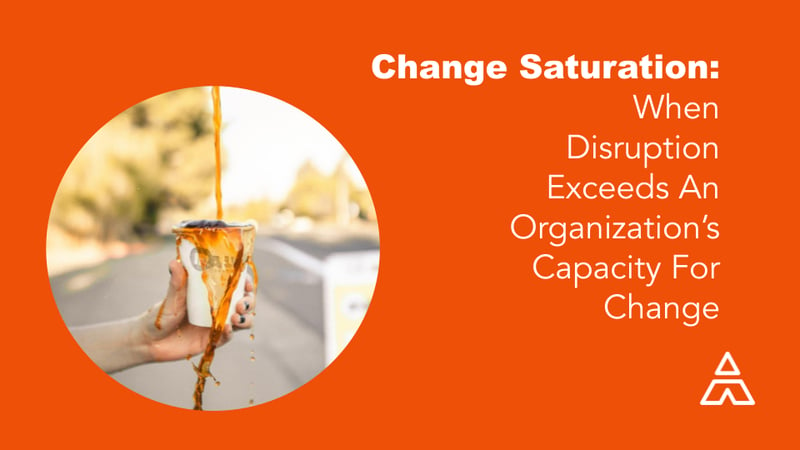
The Methods
The methodologies we currently use to implement technology and introduce it to humans are creating the problems that we're trying to solve. So to see those problems resolved, we must create human-centered methods that do things differently. Part of our think bank is inventing methods and evaluating their outcomes. The goal isn't perfection; the goal is an improvement, and as long as we see better outcomes, we're moving in the right direction. Our ecosystem is entrenched in technology failure, and we keep trying to solve all the problems with technology; we stopped believing in humans. We think humans are the solution (and it wouldn't hurt if software platforms stopped marketing the idea that "our technology is so easy, it practically drives itself")!
We have invented two methods at The Human Stack. One is a Digital Health Scorecard that assesses six vitals, three of which are human stack and three of which are tech stack. The other is an implementation strategy for digital maturity on the human stack called Digital Guidance®.
Digital Guidance®: Accessible Self-Guided Transformation
The Human Stack has a goal of creating self-guided accessible Digital Transformation for organizations of all sizes. Right now, Digital Transformation is an elite service provided only for the world's largest organizations and nonprofits. One of the main reasons for this is that it doesn't work today. We believe this is because of the single dimension model and that Digital Transformation focuses only on creating better cars and doesn't know how to focus on better drivers.
For the past three years, The Human Stack has been experimenting with a new methodology built for humans regardless of the tech stack. We call this methodology Digital Guidance® because we create an internal team that becomes experts at guiding other departments through Digital Transformation. Our methodology creates measurable change for existing teams on existing technology (as long as there's a culture of authenticity and transparency and the technology is collaborative and cloud-based).
This methodology works within organizations' change saturation levels, takes an organization through our Theory of Change and builds systems to support the North Star of data-informed decisions. Because most nonprofits lack the funding to hire consulting resources, we are creating a self-guided accessible online course and community to support the humans that foster and guide Digital Transformation. We are creating certifications for individuals to learn our methodology and for organizations to support staff development by certifying their staff. Check out our Organization Transformation page.
Powered By The Human Stack: A Partnership Program
We are currently developing a partnership program called Powered by The Human Stack that would allow consulting firms to partner with us to learn how to deliver Digital Guidance® to their clients. We believe the future of consulting and professional services is independent services for each stack. All existing services focus on the tech stack, and professional service firms must pivot to focus on the human stack. To learn more, visit our Partners page.
Funding Digital Transformation At Scale
The efforts of philanthropy to create repeatable Digital Transformation initiatives at scale have largely fallen short. This is not from a lack of studying the issues, partnering with technology, or intention to see this issue resolved. One of the core issues is that attempts have focused on creating technology solutions for human-centered problems which cannot work. Our ecosystem has failed to succeed in innovation and invention of professional services that deliver the last mile of technology. The Human Stack is already creating approaches to self-guided Digital Transformation at scale. We are ready to partner with foundations that recognize repeating the past won't change the future. If you are interested in this conversation, whether you are a non-profit, a service provider, or a philanthropist, please reach out because we would love to hear your thoughts.
The Movement
One of the cardinal rules for entrepreneurs is “Don’t boil the ocean” the idea is to create saucepan-sized initiatives. Which is right when it comes to a startup. But The Human Stack is an upstart, not a startup, and we can’t help but think bigger than saucepans. Because that’s what it’s going to take to see the kind of change required for nonprofit digital transformation. For that, we need a Movement.
There have been countless attempts to create ubiquitous digital transformation on the tech stack that won’t work because a fleet of cars without drivers isn’t going anywhere. Movements are as human stack as it gets, and movements boil oceans for breakfast because they foster human exchange.
In Montana, the temperatures during the winter drop to -20°. Yes, that’s a minus. You get to zero degrees (32° lower than freezing) and then go for another 20, so 50° below freezing. This means we care about the heat a lot. There are several ways to heat our houses, but the luxury version is radiant floor heat. There are water lines under the floor that have hot water flowing through them. We have it, and it’s incredible to walk on toasty floors when it’s freezing outside. But here’s the crazy part, there are two pools of water. The boiler heats up one pool of water. And that pool heats another pool of water that loops under the floor. These two pools never touch. They both go through a heat exchanger, which transfers heat from the boiler water to the floor water. And really, the small pool of boiler water heats 7 other loops through that one heat exchanger.
How does this relate? There is no single software platform, no single foundation, no government program, no single consulting firm, and no single nonprofit that can create an ecosystem-wide tipping point. The ocean of our ecosystem is too big; we will have to work together to make this change, which is a movement.
Our role in this movement is a heat exchanger. We’re close to the boiler, but we’re small. So let’s start exchanging ideas. Because it’s the exchange, not the ideas, that creates energy, and that energy creates heat. That’s how we boil this ocean, not by our ideas but by the energy of exchange. Whether it’s the exchange of ideas, exchange of code, exchange of passion, exchange of staff, exchange of information, or funding, the exchange creates the energy to power social transformation. Enough heat, enough water, enough idea exchange, and a warm ocean is just a hot tub the size of an ecosystem.
The Human Stack isn’t here to own this movement because movements aren’t brand-centric, but we can play a role because movements have centers, and the center of a digital transformation movement will always be human. And you’re a human too, and if you’re reading this, you might be in tech. Another word for exchange is to share, so please help us share our mindset. The mindset is intentionally simple, small, and sticky, so it’s shareable. So join and share the conversation on LinkedIn, share a TikTok video, join a webinar, and take our course.
Did you enjoy learing about our ethos?
Get updates and great information right in your inbox, it's easy!

